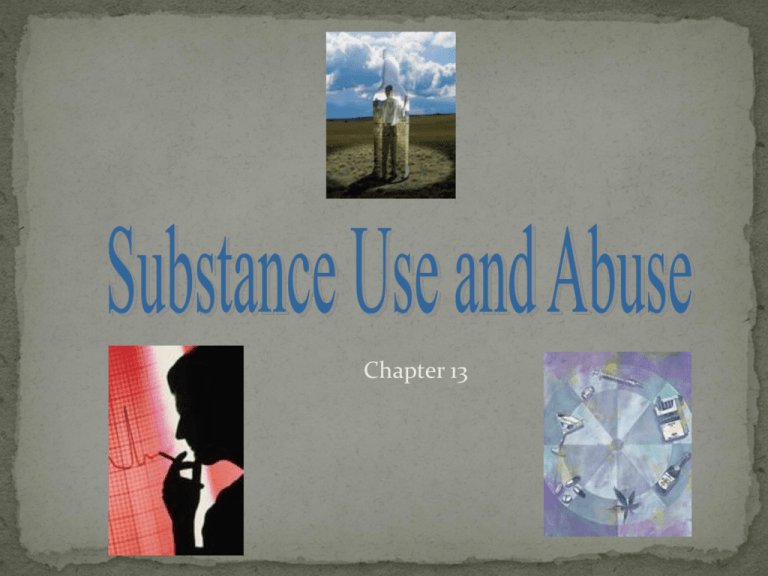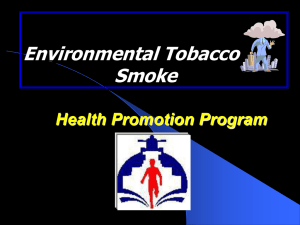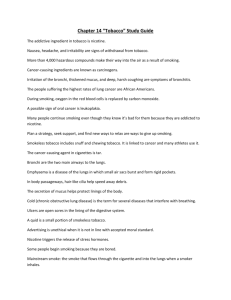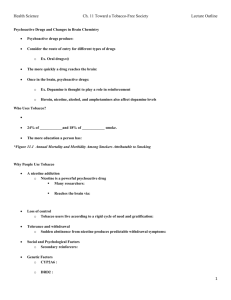
Chapter 13
Habits that have gotten out of control, with a
resulting negative effect on a person’s health.
Addiction is the habitual use of a drug produced
chemical changes in the user’s body.
Drug Addiction (four important characteristics)
Compulsive desire
2. Need to increase the dosage
3. Harmful effects to the individual
4. Harm to society
1.
2
Often starts to bring pleasure or to avoid pain.
Harmless or even beneficial if done in moderation
Examples of addictive behaviors:
Gambling
Compulsive Exercising
Work Addiction
Sex and love addiction
Compulsive buying or shopping
Internet addiction
Characteristics of people with addition (e.g., risk takers or
genetic disposition)
3
Drugs are chemicals other than food that are intended
to affect the structure or function of the body
Prescription medicines
Over-the-counter substances
Caffeine
Tobacco
Alcohol
Illegal substances
4
The APA’s Diagnostics and Statistical Manual of
Mental Disorders – authoritative reference
Abuse
APA definition
Failure to fulfill major responsibilities
Drug use in situations that are hazardous
Drug related legal problems
Drug use despite persistent social or interpersonal problems
Physically dependent may or may not present
5
Substance dependence
1. Developing tolerance to the substance
2. Experiencing withdrawal
3. Taking in larger amounts
4. Expressing a persistent desire to cut down
5. Spending great deal of time obtaining
6. Giving up or reducing important activities
7. Continual usage even with recognition of a
problem
Diagnosed with at least 3 or more symptoms
during a 12-month period
6
All income and education levels
All ethnic groups
All ages
Young people are at a higher risk
Males (Twice as likely)
Troubled adolescent
Thrill-seeker
Dysfunctional families
Peer group or family that accepts
Low Socio-economical status
Dating young
7
Experiment
Escape
Reliance
Magnification of residence (i.e. the need for escape
from poverty becomes more compelling)
8
Psychological risks
Difficulty in controlling impulses
Strong need for excitement
Feelings of rejection
Hostility
Aggression
Anxiety
Mental illness
Dual (co-occurring disorders)
9
Social Factors
Growing up in a family with drug abuse
Peer group
Poverty
10
Intoxication
Side effects
Unknown drug constituents
Risks associated with injection drug use
Legal consequences
11
Changes in Brain chemistry
Drug factors:
Pharmacological properties
Dose-Response function
Time-action function
Drug use history
Method of use (e.g., inhalation,
injection, ingest)
12
Opioids (narcotics)
Natural or synthetic (laboratory-made)
Opium, morphine, heroin, methadone, codeine,
hydrocodone, oxycodone, meperidine, and fentanly
Effects on the body: induced euphoria
Methods of administration
Injection, snorting, sniffing or smoking
Symptoms of overdose: respiratory depression, coma,
constriction of the pupils, or death.
13
Slow down the overall activity of the CNS
Sedative-hypnotics
Types: barbiturates, valium, methaqualone, GHB
Effects on the body: reduce anxiety, impair muscle
coordination, induce drowsiness
Medical uses: Treat insomnia and anxiety disorders;
control seizures
From use to abuse (“Club Drugs”)
Overdosing may result in respiratory
complications
15
Speed up the activity of the nervous or muscular
system
Cocaine
Methods of use (snort or injection)
Effects (euphoria sensation for ~5 to 20 minutes)
Use during pregnancy (consequences include:
miscarriage, premature labor, stillbirth, and low-birth-weight
baby)
16
Amphetamines
Effects (increase in alertness)
Dependence (may lead to the development of a temporary
state of paranoid psychosis or delusion)
Ritalin (used to treat attention-deficit/hyperactivity
disorder, ADHD)
Ephedrine (a less potent form of amphetamines)
Caffeine
18
19
Cannabis Sativa
THC (tetrahydrocannabinol)
Short term effects and uses: euphoria, increases in
sensation, relaxed attitude
Long-term effects and uses: respiratory damage such
as impaired lung function and chronic bronchial
irritation
21
Altered state of consciousness, perceptions, feelings and
thoughts
LSD, Mascaline, DMT, MDMA, Ketamine, PCP (angel
dust), and certain mushrooms
Altered states of consciousness
Flashbacks are perceptual distortions and bizarre
thoughts that occur after the drug has been entirely
eliminated from the body.
23
Nearly all inhalants produce effects similar to those of
anesthetics, slow down the bodies functions
Volatile solvents
Nitrates
Anesthetics
Methods of use
Sniffing
Snorting
“Bagging”
“Huffing”
24
Medication-assisted treatment
Drug substitution
Treatment centers
Self-help groups and peer counseling
Harm reduction strategies
Codependency
http://www.youtube.com/watch?v=J46pvxFWNTY
25
Tobacco
Use of Tobacco
71 Million Americans, including 13.7 million college-aged
Americans.
2008, nearly 21% of Americans age 18 describe themselves as
current smokers.
Nicotine Addiction
Powerful psychoactive drug
Reaches Brain via bloodstream in seconds
Most physically addictive of the psychoactive drugs.
Loss of control
Tolerance and Withdrawal
27
Why Start in the First Place?
Children and teenagers make-up 90% of all new smokers in
this country.
Thousands of children and adolescents (12-17) start smoking
everyday.
Average age
13 for smoking
10 for spit tobacco
28
Characteristics which could increase the
potential for use.
A parent or sibling uses tobacco
Peers use tobacco
Child comes from blue-collar family
Child comes from low-income home
Single parent.
Performs poorly in school
Child drops out of school
Has positive attitudes towards tobacco
29
Reasons Why College Students Smoke
Health Hazards
Contains hundreds of damaging chemical substances,
including acetone (nail polish remover), ammonia,
hexamine (lighter fluid), and toluene (industrial
solvent).
Unfiltered cigarettes = 5 billion particles per cubic mm
50,000 times more than polluted urban air
Condensed particles in the cigarette produce the tar
(brown, sticky mass)
Chapter 8
31
Health Hazards (cont)
Carcinogens and Poisons
43 chemicals are linked to cancer (Carcinogen)
Benzo(a)pyrene (yellowish tar)
Urethane (ex: solution used in making foams)
Cocarcinogens
Combine with other chemicals to cause cancer (e.g., formaldehyde)
Poisonous substances
Arsenic (e.g., insectides and weed killers)
Hydrogen cyanide (e.g., flammable liquid used in dye)
Carbon monoxide
400 times greater than is considered safe in industrial workplaces
Displaces oxygen in red blood cells
Additives
Nearly 600 chemicals
Chapter 8
32
33
“Light” and Low-Tar Cigarettes
Low-tar, low-nicotine, or filtered cigarettes
No such thing as a safe cigarette
Often smoke more
34
The effects of smoking a cigarette
35
Additional Health, Cosmetic, and
Economic Concerns
Ulcers
Impotence
Reproductive health problems
Dental diseases
Diminished physical senses
Injuries
Cosmetic concerns
Economic costs
36
Cumulative Effects
Males before 15 yrs. old are half as likely to live to 75
versus those who did not smoke
Females with similar habits reduce life expectancy by
more than 10 years
Female smokers spend 17% more sick days in bed
than nonsmokers
Both men and women show a greater rate of acute
and chronic diseases
37
Other Forms of Tobacco
Spit (Smokeless) Tobacco
More than 6.6 million adults
8% of all high school students
Cigar and Pipes
Cigar smoking has increased
by 148% from 1993-2006.
Cigars contain more tobacco
than cigarettes.
Clover cigarettes and Bidis
Twice the tar, nicotine, and
carbon monoxide
38
39
The Effects of Smoking on the Nonsmoker
Environmental Tobacco smoke (ETS)
Environmental Protection Agency (EPA) designated
ETS as a class A carcinogen
Department of Health and Human Services’ National
Toxicology Program - “known human carcinogen”
Surgeon General – 2006 – “there is no safe level of
exposure to ETS; even brief exposure can cause serious
harm”.
40
Environmental Tobacco Smoke
Mainstream smoke
Smoke exhaled by smokers
Sidestream smoke
Smoke from the burning end of a cigarette, cigar, or pipe.
85% of smoke in a room is second hand
Twice the tar and nicotine
Three times the benzo(a)pyrene
Three times the ammonia
Smoke from a cigar can be even more dangerous
30 times more carbon monoxide
41
ETS Effects
Develop cough, headaches, nasal discomfort, eye irritation,
breathlessness and sinus problems
Allergies will be exacerbated
Causes 3,000 deaths due to lung cancer
Contributes to about 35,000 overall deaths each year.
20% increase in the progression of atherosclerosis.
Contributes to increased asthma attacks
42
How Cigarette Smoking Damages the Lungs
Lung Cancer from Tobacco Smoking
44
Oral Cancer from Tobacco Smoking
45
Oral Cancer from Tobacco Smoking
http://www.youtube.com/w
atch?v=0hySFt8O11A
46
Cancer Survivor
47
Infants, Children, and ETS
More likely to develop
Bronchitis, pneumonia,& respiratory infections
More complications from asthma
Increased chance of SIDS (sudden infant death syndrome)
Low-birth weight
Bronchitis
Chemicals from smoking show up in breast milk
Children inhale three times more pollutants per unit of body
weight than adults.
48
Smoking and Pregnancy
Estimated 4,600 infant deaths in the U.S.
Miscarriage, premature birth, low birth weight,
long term impairments in growth and intellectual
development
Possible higher risks of getting cancer
16% of pregnant women smoke
49
Cost of Tobacco Use to Society
Lost productivity from sickness, disability, and
premature death makes it close to $167 billion per
year.
1998 Master Settlement Agreement (MSA)
43 states filed suit against tobacco companies to
recoup public health care expenditures
Tobacco companies have to pay $206 billion over 25
years.
Limits or bans certain types of advertising,
promotions, and lobbying.
50
How A Tobacco User Can Quit
50.2 % of all adults who have smoked have quit.
The Benefits of Quitting
Options for quitting
Smoking cessation programs
1-800-QUITNOW
Smoking cessation products
Department of Health and Human Services
Chantix (Varinicline)
Zyban (Bupropion)
Nicotine replacement products
Patches, gums, lozenges, nasal sprays, and inhalers
http://www.videojug.com/interview/the-benefits-of-quitting-smoking-2
51
Alcohol
The Nature of Alcohol
Psychoactive ingredient
Depressant
Ethyl Alcohol – only alcohol that can be consumed
Beer 3-6% alcohol by volume
Malt Liquors 6-8% alcohol by volume
Table wines 9-14% alcohol by volume
Fermenting
Fortified wines 20% alcohol by volume
Sugar added
Extra alcohol is added
Hard liquors 35-50% alcohol by volume
Distilling or fermented
Proof Value
Two times the percentage concentration
Ingestion
7calories per gram
1 drink 14-17 grams or 100-120 calories
53
Absorption
20% is rapidly absorbed from the stomach
75% is absorbed in the upper small intestines
Remain is absorbed along the GI track
Absorption
Carbonation
Food in the stomach slows the absorption
Eventually all the alcohol ingested will be absorbed
54
Metabolism and Excretion
Transported throughout the body via the
bloodstream.
Easily moves through most biological membranes
Main site for metabolism is the Liver.
2-20% of ingested alcohol is not metabolized.
55
Chapter 8
56
Alcohol Intake and Blood Alcohol Concentration
Blood Alcohol Concentration(BAC)
A measure of intoxication
Body weight
Percentage of body fat
Sex
Genetic factors
Drinking Behavior
Metabolism is the same if the person is
awake or asleep
57
The Immediate Effects of Alcohol on Health
Depends on the individual.
Low Concentrations .03% -.05%.
Higher Concentrations 0.1% -0.2%.
Concentration of .35% and higher.
Alcohol hangover
Alcohol poisoning
Using Alcohol with other drugs
58
Drinking and Driving
In 2004
250,000 were injured in alcohol related automobile
crashes
42,000 people are killed in alcohol related accidents
Dose-response function
Driving with a BAC of 0.14% is more
than 40 times more likely to be
involved in a crash.
Greater than 0.14% the risk of fatal
crash is estimated to be 380 times higher.
59
60
Angels Pitcher Nick Adenhart Killed In Car Crash
April 9, 2009
Two people who were with him were also killed when, according to police, a minivan ran a red light at a
Fullerton intersection and broadsided the gray Mitsubishi they were in. The driver of the minivan, Andrew
Thomas Gallo, 22, of Riverside, was arrested on suspicion of drunken driving, hit and run and manslaughter.
61
Approximate blood concentration and body weight
© 2010 McGraw-Hill Companies. All Rights Reserved.
62
The Effects of Chronic Use
Diseases of the digestive, cardiovascular systems and some cancers
Digestive system
Liver function
liver cell damage and destruction (cirrhosis)
Pancreas inflammation
Cardiovascular system
moderate doses may reduce the risk of HD
Higher doses elevates BP, may weaken heart muscle or cardiac myopathy.
Cancer
5-6 total drinks
Hepatitis speeds the growth of this cancer
Increase risk when 2-3 drinks per day
Responsible for the most common form of liver cancer
Breast cancer
Brain Damage
Mouth, throat, larynx, and esophagus
Cognitive impairments
Memory loss, dementia, and compromised problem-solving
Wernicke-Korsakoff syndrome (brain damage)
Mortality
Alcoholics average life expectancy is about 15 years less than non-alcoholics
63
64
The Effects of Alcohol use During Pregnancy
Effects are dose-related.
Fetal Alcohol Syndrome (FAS)
Full-blown FAS occurs in up to 15 out of every 10,000 live
births in the U.S.
Under weight, flat nasal bridge, and long upper lip.
Small and have heart defects.
Physical and mental growth is slowed. Remain mentally
impaired. Fine motor skill problems, coordination, learning and
behavioral problems (ADS).
Alcohol-related neurodevelopment disorder (ARND).
65
Possible Health Benefits of Alcohol
Abstainers and light to moderate drinkers live longer
than heavy users.
35 years old and younger, your odds of dying
increase in proportion to the amount consumed
Moderate drinking = one drink per day for women
and two drinks per day for men.
May lower coronary heart disease.
Raising blood levels of HDL.
May lower risks of diabetes, arterial blockages, Alzheimer’s
66
Alcohol Abuse and Dependence
Alcohol abuse is recurrent use that has negative
Alcohol dependence or Alcoholism more extensive
consequences.
problems, tolerance and withdrawal
Warning signs of alcohol abuse
Drinking alone
Using deliberately and repeatedly
Feeling uncomfortable on certain occasions
Escalating consumption
Getting drunk regularly
Drinking in the morning or unusual times
67
Alcohol Abuse and Dependence
Binge Drinking
The National Institute on Alcohol Abuse and Alcoholism
defines:
Pattern of alcohol use that brings a person’s BAC up to
0.08 or above (typically four drinks for a male or three
for a women) within two hours.
National Survey on Drug Use and Health defines:
Having five drinks in row for a man or four in a
a women within two hours.
row for
Frequent binge drinking in college were three to seven
times more likely than non-binge drinkers to engage in
unplanned or unprotected sex
Healthy People 2010
Reduce the rate of binge drinking to 20% among
college students
68
Alcoholism
Patterns and Prevalence
1.
Regular daily intake of large amounts
2. Regular heavy drinking limited to weekends
3. Long periods of sobriety interspersed with binges or daily heavy
drinking
4. Heavy drinking limited to periods of stress
Health Effects
DTs (delirium tremens)
paranoia
Social and Psychological effects
Causes of Alcoholism
Video: http://www.youtube.com/watch?v=gTPjlN7VR7c
70
Treatment Programs
Not one program works for everyone.
AA.
12-step program
Employee Assistance.
Inpatient hospital rehabilitation
Pharmacological treatments.
Disulfiram (Antabuse)
Inhibits the metabolic breakdown
Naltrexone (ReVia, Depade)
Reduces the craving for alcohol and decreases its pleasant effects.
Injectable Naltrexone (Vivtrol) – single monthly shot
Acamprosate (Campral)
Acts on brain pathways related to alcohol abuse.
71
Gender and Ethnic Differences
Men
White American men (excessive drinking often begins in the
teens or twenties)
“Other men” (remain controlled drinkers until later in life)
Women (alcoholism often occurs
later in life)
African Americans (alcohol abuse
usually found in African Americans)
Latinos (drinking patterns vary)
Asian Americans (low rate of alcohol abuse)
American Indians and Alaska Natives (excessive drinking varies from
tribe to tribe)
http://www.cbsnews.com/video/watch/?id=5024746n
Chapter 8
72
Video Segment:
The Effects of Drug Use on Brain Chemistry
http://www.youtube.com/watch?v=J46pvxFWNTY
http://www.aetv.com/intervention/video/?bcpid=534114
97001&bclid=129113967001&bctid=115543473001
http://www.aetv.com/intervention/video/?bcpid=534114
97001&bclid=64419253001&bctid=64670639001
73








